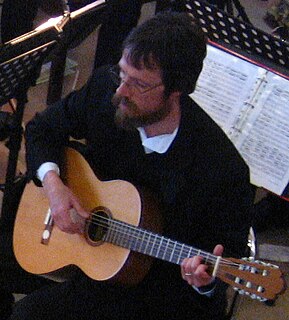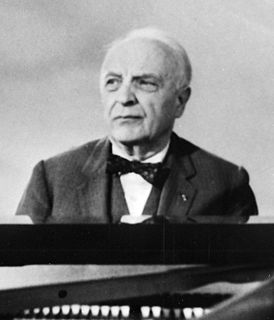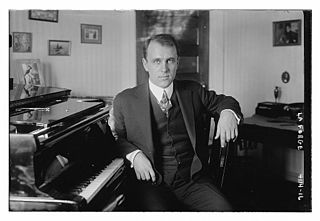Related Research Articles

A piano concerto is a type of concerto, a solo composition in the classical music genre which is composed for a piano player, which is typically accompanied by an orchestra or other large ensemble. Piano concertos are typically virtuoso showpieces which require an advanced level of technique on the instrument. These concertos are typically written out in music notation, including sheet music for the pianist, orchestra parts for the orchestra members, and a full score for the conductor, who leads the orchestra in the accompaniment of the soloist.

Accompaniment is the musical part which provides the rhythmic and/or harmonic support for the melody or main themes of a song or instrumental piece. There are many different styles and types of accompaniment in different genres and styles of music. In homophonic music, the main accompaniment approach used in popular music, a clear vocal melody is supported by subordinate chords. In popular music and traditional music, the accompaniment parts typically provide the "beat" for the music and outline the chord progression of the song or instrumental piece.

Gerald Moore CBE was an English classical pianist best known for his career as a collaborative pianist for many distinguished musicians. Among those with whom he was closely associated were Dietrich Fischer-Dieskau, Elisabeth Schumann, Hans Hotter, Elisabeth Schwarzkopf, Victoria de los Ángeles and Pablo Casals.

Robert Marcel Casadesus was a renowned 20th-century French pianist and composer. He was the most prominent member of a distinguished musical family, being the nephew of Henri Casadesus and Marius Casadesus, husband of Gaby Casadesus, and father of Jean Casadesus.
Samuel Hans Adler is an American composer, conductor, author, and professor. During the course of a professional career which ranges over six decades he has served as a faculty member at both the University of Rochester's Eastman School of Music and the Juilliard School. In addition, he is credited with founding and conducting the Seventh Army Symphony Orchestra which participated in the cultural diplomacy initiatives of the United States in Germany and throughout Europe in the aftermath of World War II. Adler's musical catalogue includes over 400 published compositions. He has been honored with several awards including Germany's Order of Merit – Officer's Cross.

An art song is a Western vocal music composition, usually written for one voice with piano accompaniment, and usually in the classical art music tradition. By extension, the term "art song" is used to refer to the collective genre of such songs. An art song is most often a musical setting of an independent poem or text, "intended for the concert repertory" "as part of a recital or other relatively formal social occasion". While many pieces of vocal music are easily recognized as art songs, others are more difficult to categorize. For example, a wordless vocalise written by a classical composer is sometimes considered an art song and sometimes not.

In music, a trio is any of the following:
Vasif Zulfugar oghlu Adigozalov was one of Azerbaijan's most distinguished composers. He is the son of khananda Zulfu Adigozalov, brother of violinist and singer Rauf Adigozalov and the father of conductor Yalchin Adigozalov.
Artur Balsam was a Polish-born American classical pianist and pedagogue.

Geoffrey Penwill Parsons AO OBE was an Australian pianist, most particularly notable as an accompanist to singers and instrumentalists. After the retirement of Gerald Moore, he was generally considered the world's finest and most sympathetic accompanist of lieder singers, "elevating the role of the accompanist to new heights with his musicality, authority and quiet strength of playing".
Lubor Bárta was a Czech composer.
Simon Lepper is a British pianist specialising in song accompaniment and chamber music
Yardena Alotin was an Israeli composer and pianist. As a pianist and teacher, Alotin also wrote educational music and music for young musicians, such as Six Piano Pieces for Children. Alotin won the Nissimov Prize for her 1956 work, Yefei Nof.

Frank La Forge was an American pianist, vocal coach, teacher, composer and arranger of art songs.
Richard Faith was an American composer who has been known primarily in university music circles as a concert pianist, professor of piano, and a published composer of piano pedagogy literature, orchestral and chamber works, opera and most prolifically, song. A neo-romantic, Faith has always been first and foremost a melodist.
Celius Hudson Dougherty was an American pianist and composer of art songs and other music.

Isidor Yulyevich Achron was a pianist, composer and music teacher.

Ferdinand Weiss was a Romanian collaborative pianist and a professor at the Gheorghe Dima Music Academy of Cluj-Napoca, Romania.

Richard Strauss composed his Cello Sonata in F major, Op. 6, TrV 115, in 1883 when he was 19 years old. It was dedicated to the Czech cellist Hanuš Wihan, who gave the premiere in 1883. It rapidly became a standard part of the cello repertoire.
Božidar Kunc was a Croatian composer and pianist. He studied at the Academy of Music, University of Zagreb. From 1951 he worked as a teacher in New York. His sister was a famous soprano Zinka Milanov.
References
- ↑ "Collaborative Piano Studies". NYU Steinhardt. Retrieved 10 March 2014.
- ↑ Adler, Kurt (1965). The Art of Accompanying and Coaching. Minneapolis: The University of Minnesota Press. p. 16. ISBN 978-0816660742.
- ↑ Jepson, Barbara (April 16, 1989). "Who's That Man With Marilyn Horne?". The New York Times. p. 6006033. Retrieved 2018-06-07.
- ↑ Elliott, Noelle (January 9, 2017). "Three of the World's Leading Collaborative Pianists to Teach and Perform at Notre Dame". Department of Music. Retrieved 2018-06-07.